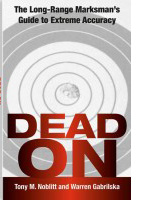

Wind correction has been the cause of more misses in the hunting field than it’s given credit for. The first step to correcting for wind is estimating its speed and value.
A wind meter will be the most precise gauge for determining speed and will help provide the value of effect on the bullet path. However, many times there won’t be time or one will not be available. If one is available, hold it next to the rifle so the fan blade is parallel to the bore to determine wind speed perpendicular to the bullet’s flight. The wind value also will be included because the wind hitting the fins at an angle will not spin the blades like a 90-degree wind.
If a wind meter is not handy, natural flags in the woods like trees, shrubs and grass will help the shooter estimate the speed. A 3 to 5 mph wind will be felt lightly on the face, a 5 to 8 mph wind will make leaves in the trees agitate continuously, while an 8 to 12 mph wind will blow dust into the air. When the wind hits 12 to 15 mph, small trees will sway and bushes will blow from side to side.
Even if you have the availability of a wind meter, like one from Kestrel, it’s good to note visual indicators between you and the target to determine variances over the full distance of the shot. Comparing velocities in the meter with the actions of the shrubbery will help estimate the wind downrange when all you have is the movement of the shrubs.
Another way of estimating wind is with mirage. Mirage is the wavy effect that heat makes as it is rising from the ground. This method is accurate up to about 12 mph. Mirage is visible with the naked eye but can be magnified with the spotting scope. To see mirage focus the scope on the distant target and then rotate the focus to blur the target. The heat shimmer barely noticeable with the naked eye becomes amazingly clear.
If the mirage rises straight up there is no wind. If the mirage tips about 60 degrees, the wind is 1 to 3 mph and direction is the way the top is leaning. Forty-five degrees will indicate the wind is about 4 to 7 mph, and mirage parallel to the ground is 8 to 12 mph.
Next calculate the value it will have on the bullet path and adjust your aim accordingly. To become proficient, practice shooting on windy days and keep detailed notes of every shot.
This article appeared in the April 8, 2013 issue of Gun Digest the Magazine.
Recommended Shooting Resources


![Best Concealed Carry Guns In 2025 [Field Tested] Wilson Combat EDC X9S 1](https://gundigest.com/wp-content/uploads/Wilson-Combat-EDC-X9S-1-324x160.jpg)


![Best 9mm Carbine: Affordable PCCs [Tested] Ruger Carbine Shooting](https://gundigest.com/wp-content/uploads/Ruger-Carbine-Shooting-100x70.jpg)
![Best AR-15: Top Options Available Today [Field Tested] Harrington and Richardson PSA XM177E2 feature](https://gundigest.com/wp-content/uploads/Harrington-and-Richardson-PSA-XM177E2-feature-100x70.jpg)
